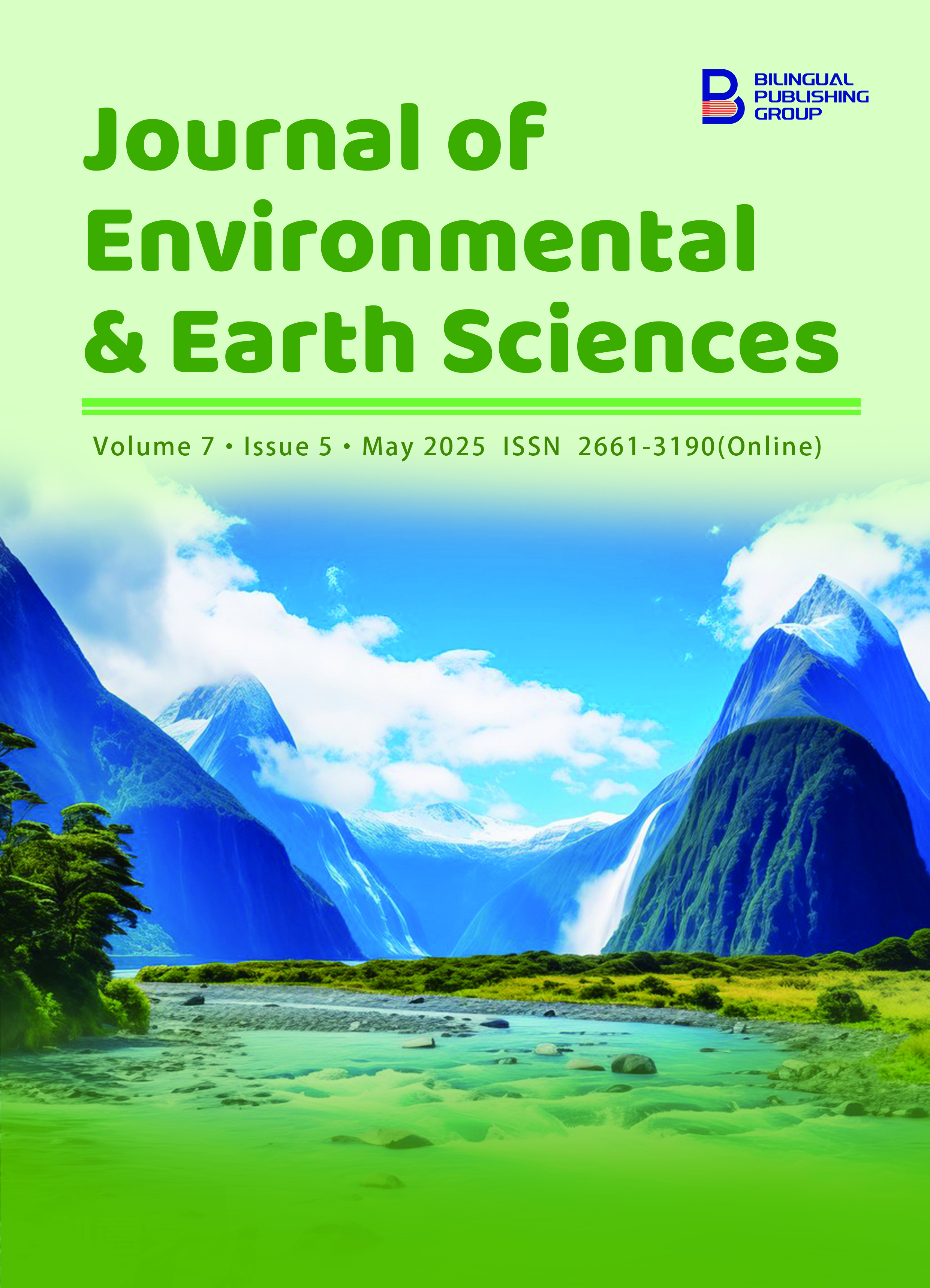
Comprehensive Utilization of Borehole AFET and Logging Method Detecting Goaf Area in Coal Mines
DOI:
https://doi.org/10.30564/jees.v7i5.7934Abstract
China, as the world's largest coal producer and consumer, faces increasingly severe challenges from coal mine goaf areas formed through decades of intensive mining. These underground voids, resulting from exhausted resources or technical limitations, not only cause environmental issues like land subsidence and groundwater contamination but also pose critical safety risks for ongoing mining operations, including water inrushes, gas outbursts, and roof collapses. Conventional geophysical methods such as seismic surveys and electromagnetic detection demonstrate limited effectiveness in complex geological conditions due to susceptibility to electrical heterogeneity, electromagnetic interference, and interpretation ambiguities.This study presents an innovative integrated approach combining the Audio-Frequency Electrical Transillumination (AFET) method with multi-parameter borehole logging to establish a three-dimensional detection system. The AFET technique employs 0.1-10 kHz electromagnetic waves to identify electrical anomalies associated with goafs, enabling extensive horizontal scanning. This is complemented by vertical high-resolution profiling through borehole measurements of resistivity, spontaneous potential, and acoustic velocity. Field applications in Shanxi Province's typical coal mines achieved breakthrough results: Using a grid-drilling pattern (15m spacing, 300m depth), the method successfully detected three concealed goafs missed by conventional approaches, with spatial positioning errors under 0.5m. Notably, it accurately identified two un-collapsed water-filled cavities. This surface-borehole synergistic approach overcomes single-method limitations, enhancing goaf detection accuracy to over 92%. The technique provides reliable technical support for safe mining practices and represents significant progress in precise detection of hidden geological hazards in Chinese coal mines, offering valuable insights for global mining geophysics.
Keywords:
Underground Coal Mine; Goaf; Audio-Frequency Electrical Transillumination (AFET); Gamma Logging; Borehole ImagingReferences
[1] Yang, Y., 2023. Three dimensional forward and backward modeling research and application of frequency domain controllable source electromagnetic method in coal mine goaf [PhD thesis]. Guilin, China: Guilin University of Technology. pp. 20–28.
[2] Liu, W., 2023. Application research of comprehensive geophysical exploration technology in coal mine goaf detection. Energy and Energy Conservation. 05, 193–195+211.
[3] Xiao, L., 2019. Application of comprehensive geophysical methods in goaf detection. Journal of Engineering Geophysics. 16(05), 658–664.
[4] Liu, Y., 2008. Seismic exploration methods on goaf. Coal Technology. 27(4), 100–101.
[5] Fan, T., Li, H., Guo, J., et al., 2020. Application of borehole transient electromagnetic pseudo seismic inversion method in fine exploration of goaf in open-pit coal mines. Journal of Earth Science and Environment. 42(6), 759–766.
[6] Lin, J., Xue, G., Li, B., 2021. Innovative thinking on semi aerial electromagnetic detection method technology. Chinese Journal of Geophysics. 9, 2995–3004.
[7] Liu, K., Wang, Q., Pang, X., 1992. Preliminary experiment of high-density resistivity method. Exploration Science and Technology. 2, 54–56.
[8] Cheng, J., Hu, K., Wang, Y., et al., 2004. Research on ground penetrating radar detection of underground mining areas. Geotechnical Mechanics. 25(S1), 79–82.
[9] Wang, D., 2015. Application of geophysical methods in the detection of goaf in coalfields. Technology Outlook. 25(04), 139.
[10] Mo, L., 2019. Research on comprehensive geophysical exploration method for coal mine goaf in LZC area, Inner Mongolia [PhD thesis]. Xuzhou, China: China University of Mining and Technology. pp. 25–38. DOI: https://doi.org/10.27623/d.cnki.gzkyu.2019.000290
[11] Wang, S., Yang, C., 2015. Bell ringing Selection of detection methods for goaf. Coal Technology. 34(09), 225–228. DOI: https://doi.org/10.13301/j.cnki. ct. 2015.09.085
[12] Hu, F., Wu, M., Xu, D., et al., 2018. Using electromagnetic wave CT technology for perspective imaging in karst areas. CT Theory and Application Research. 27(02), 205–212. DOI: https://doi.org/10.15953/j.1004-4140.2018.27.02.09
[13] Liang, C., Huang, H., 2010. Application of inter hole electromagnetic wave perspective and CT scanning in geological exploration of Karst areas. Water Resources Planning and Design. 04, 25–27.
[14] Gan, F., Li, H., Lu, C., et al., 2010. Application of cross hole electromagnetic wave perspective method in detecting and evaluating karst disease foundation of oil storage tanks. Journal of Engineering Geophysics. 7(01), 84–88.
[15] Wu, Y., Chen, Y., Nie, S., 2009. Application of cross hole electromagnetic wave perspective method in Karst exploration of Heyetang elevated bridge. Geophysical and Chemical Exploration. 33(01), 102–104.
[16] Zhang, F., 2008. Application of borehole electromagnetic wave perspective CT technology in the identification of karst caves at the bottom of Jianshan Tunnel. Technology Intelligence Development and Economics. 12, 217–218.
[17] Gan, F., Li, J., Li, H., et al., 2006. Application of cross hole electromagnetic wave perspective method in Karst exploration. Geophysical and Chemical Exploration. 04, 303–307.
[18] Guo, G., Wei, B., 1999. Application of inter well electromagnetic wave CT technology in cave detection. South China Earthquake. 04, 28–34. DOI: https://doi.org/10.13512/j.hndz.1999.04.005
[19] Wang, W., 1983. Application of borehole electromagnetic wave perspective method in engineering geological exploration. Exploration Science and Technology. 01, 6–10.
[20] Wang, W., 1999. Application example of electromagnetic wave perspective in coal mine goaf exploration. Geophysical and Chemical Exploration. 04, 75–77.
[21] Liu, L., Zhao, Z., Li, B., 2021. Tomography of electromagnetic wave attenuation coefficient between coal mine floor holes. Geophysical and Geochemical Exploration Calculation Technology. 43(01), 77–82.
[22] Yorkey, T.J., Webster, J.G., Tompkins, W.L., 1987. Comparing reconstruction algorithms for electrical impendence tomography. IEEE,Transaction on Biomedical Engineering. 34(11), 834–852.
[23] Daily, W., Owen, E., 1991. Cross-hole resistivity tomography. Geophysics. 56(8), 1228–1235.
[24] Cheng, J., Lu, Z., Jiang, B., et al., 2022. The “long excavation and long exploration” technology for rapid excavation of coal mine tunnels. Coal Journal. 47(01), 404–412
[25] Jiang, B., Zhang, P., Cong, L., et al., 2019. Design and implementation of gamma logging control system for borehole direction based on UCOS-II. Coal Technology. 38(08), 158–161 DOI: https://doi.org/10.13301/j.cnki.ct.2019.08.052
[26] Jiang, B., Tian, X., Zhang, P., et al., 2020. Research on the influence of gamma ray on azimuth measurement during borehole and its correction methods. Coal Science and Technology. 48(12), 175–181. DOI: https://doi.org/10.13199/j.cnki.cst.2020.12.022.
[27] Zhang, R., 2016. Research on logging evaluation methods for coalbed methane reservoirs [PhD thesis]. Changchun, China: Jilin University. pp. 38–48.
Downloads
How to Cite
Issue
Article Type
License
Copyright © 2025 Zipeng Guo

This is an open access article under the Creative Commons Attribution-NonCommercial 4.0 International (CC BY-NC 4.0) License.







 Zipeng Guo
Zipeng Guo






